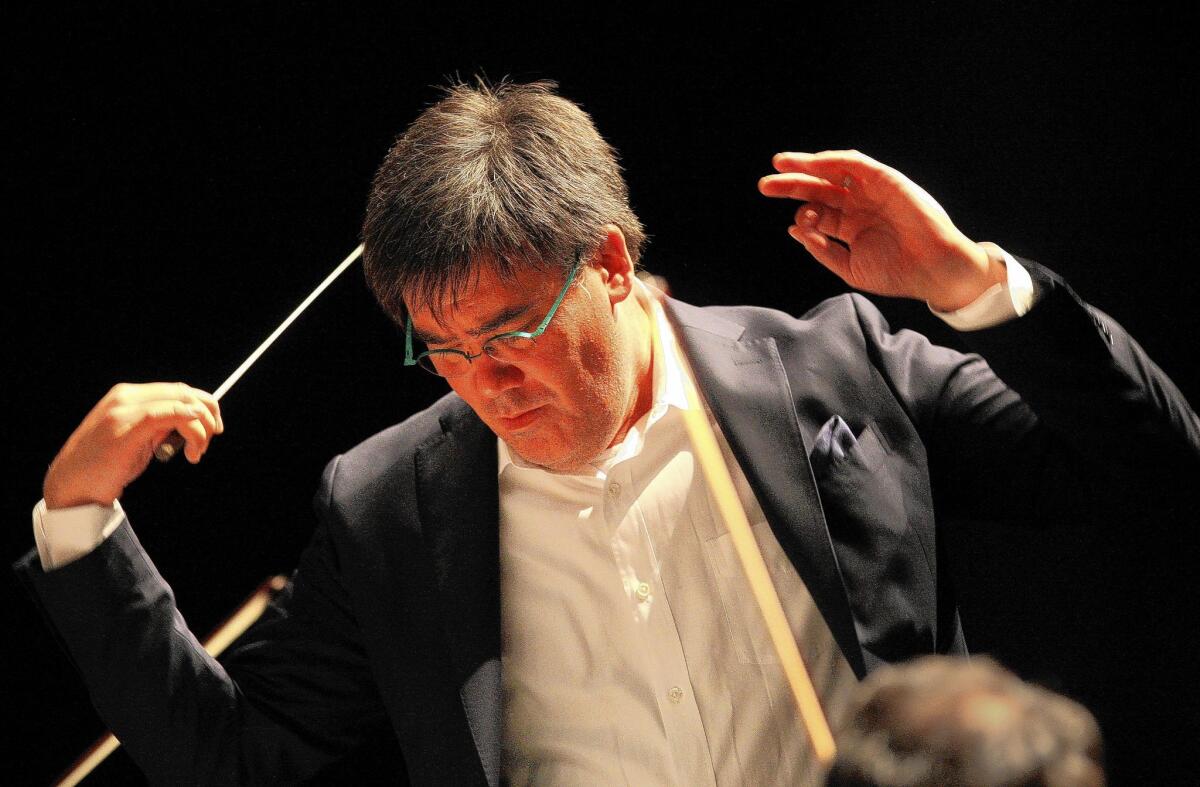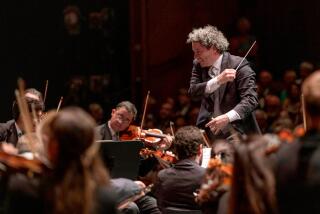Review: The Music Academy of the West’s grand adventure

The Music Academy of the West doesn’t skimp on conductors.
This year’s biggest name is New York Philharmonic music director Alan Gilbert. He led an enthusiastic chamber ensemble at the Lobero Theatre on Saturday night. It was a notable occasion, not only because the program was sensationally well played or even because it had become rare to encounter Gilbert in the U.S. outside of New York.
The real significance is that Gilbert will be back. And back, again.
The New York Philharmonic has begun a four-year association with the academy that will include an appearance by the orchestra at the Santa Barbara Bowl next summer. New York Philharmonic musicians will become part of the academy faculty, coaching players whose age range is 19 to 34.
Importing America’s oldest orchestra to Santa Barbara has raised eyebrows. That academy students will have much to gain from working with members of one of the world’s most virtuosic ensembles is not in question. That Gilbert can bring to budding orchestra players a stirring professionalism as well as a modicum of adventure was in full evidence Saturday in a challenging program of works by Schubert, Schoenberg and Thomas Adès.
But the academy’s draw has long been its West Coast tradition. Prominent Los Angeles and Bay Area performers and composers have a long history of playing a key role at the academy.
With the L.A. Phil and the San Francisco Symphony among the country’s most venturesome orchestras — and their respective music directors, Gustavo Dudamel and Michael Tilson Thomas, celebrated educators — it almost seems as though the New York Philharmonic is heading out West to see how it’s done.
To his credit, Gilbert has a devotion to young players. The 47-year-old New Yorker runs the conducting program at the Juilliard School, and he has made the New York Philharmonic’s educational activities a priority in his five years as music director.
In the intimate 600-seat Lobero, recently renovated, Gilbert looked as though nothing in the world was more enjoyable than making the academy ensemble look good, which is to say sound great. It was also a meaningful gesture on his part to include works by composers who settled in Los Angeles. Schoenberg taught at the Academy in 1949. Adès, who divides his time between Los Angeles and his native London, will be guest conducting next month.
The conceit of the evening was music by young composers feistily experimenting with the symphonic style. Schubert’s Second was written by a 17-year-old. Adès’ Chamber Symphony is a student work. Schoenberg was 32 when he premiered his Chamber Symphony in 1906, but he would still have been within the academy age limit.
Schoenberg’s score, for 15 solo instruments, is dense, exciting, ground-breaking. He condensed the big Mahlerian symphonic ideal into a piece for individuals. He radicalized harmony and form with a complex, shockingly assertive 20 minutes of the newest music for a new century.
Gilbert, though, reminded the audience that much in the score was a holdover from the Romantic era. He further made that point by adding more strings to luxuriously thicken textures, which Schoenberg originally disallowed.
Gilbert’s solution of an expanded string section, though retaining the solo strings in a few passages, was the worst of both worlds. The implication of revolution remained, but the results were retrogressive. That said, the playing was vital, and the looking back was expressive and downright gorgeous.
You can’t take the young man out of the Adès Chamber Symphony, also for 15 players, although with different instrumentation — including wacky percussion, accordion and wine bottle. It represents a 19-year-old’s sassing of Schoenberg, with off-kilter themes that coalesce into fleeting moments of magic and then thumb their melodic noses. The most intriguing Opus 2 of the 20th century, this Chamber Symphony was utterly fresh in 1990, and it remains so.
Gilbert played Adès straight, if rather carefully, and delivered a treat. But it was only with the Schubert symphony that Gilbert removed his interpretive gloves. There was a sheen to the academy sound that was reminiscent of the New York Philharmonic, and an irresistible playfulness that I’m not so sure Gilbert, who was tieless and more casually dressed than the orchestra players, could get away with back home.
This is not an important symphony, and it can be argued that these youngsters merit more mature music. So let Gilbert and the academy now move on to bigger things. Saturday, they earned it.
More to Read
The biggest entertainment stories
Get our big stories about Hollywood, film, television, music, arts, culture and more right in your inbox as soon as they publish.
You may occasionally receive promotional content from the Los Angeles Times.











